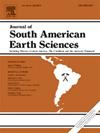Thermal structure of the Barreirinhas Basin, Brazilian equatorial margin
IF 1.5
4区 地球科学
Q3 GEOSCIENCES, MULTIDISCIPLINARY
引用次数: 0
Abstract
This study characterizes the thermal regime of the Barreirinhas Basin, located in the central sector of the Brazilian Equatorial Margin (BEM), based on 592 temperature records obtained from 85 exploratory wells, encompassing both onshore and offshore areas. Bottom-hole temperature (BHT), drill-stem test (DST), and extrapolated temperature (ET) measurements have been corrected using conventional methods, including the American Association of Petroleum Geologists (AAPG), Horner-plot, and a Linear Adjustment approach developed in this study. The AAPG method exhibited the best performance for BHT data (R2 = 0.8463), while the Linear Adjustment technique showed consistent results in DST data correction. Corrected temperatures ranged from 45 °C to 165 °C across the Barreirinhas basin, associated with geothermal gradients from 19 °C/km to 40 °C/km. The geothermal gradient decreases sharply down to 800 m, stabilizing around 30 °C/km and decreasing to 20 °C/km at depths greater than 5000 m. Thick sedimentary layers act as thermal insulators, limiting heat dissipation to the surface and reducing the geothermal gradient by the blanket effect. These thermal conditions indicate potential for liquid hydrocarbon generation between 1500 and 3500 m depth, whereas gas generation may occur at depths greater than 3550 m. The correlation between the thermal regime and the internal architecture of the basin is consistent with patterns observed in Asian transform margins, as well in the conjugate African Equatorial Atlantic margin, reinforcing the relevance of the Barreirinhas Basin as a potential reservoir for energy resource production.
巴西赤道边缘Barreirinhas盆地的热结构
本研究基于85口探井获得的592条温度记录,对位于巴西赤道边缘(BEM)中部的Barreirinhas盆地的热状态进行了表征,包括陆上和海上区域。井底温度(BHT)、钻杆测试(DST)和外推温度(ET)测量数据已经使用常规方法进行了校正,包括美国石油地质学家协会(AAPG)、Horner-plot和本研究中开发的线性调整方法。AAPG法对BHT数据的校正效果最好(R2 = 0.8463),而Linear Adjustment法对DST数据的校正效果一致。整个Barreirinhas盆地的校正温度范围为45°C至165°C,地热梯度范围为19°C/km至40°C/km。地温梯度在800 m以下急剧减小,稳定在30°C/km左右,大于5000 m时减小到20°C/km。厚厚的沉积层起到了隔热层的作用,限制了地表的热量散失,并通过毯状效应降低了地热梯度。这些热条件表明1500 ~ 3500 m深度之间有可能产生液态烃,而大于3550 m的深度可能产生天然气。热状态与盆地内部构造之间的相关性与在亚洲转换边缘以及在非洲赤道大西洋共轭边缘观察到的模式一致,加强了Barreirinhas盆地作为能源生产潜在储层的相关性。
本文章由计算机程序翻译,如有差异,请以英文原文为准。
求助全文
约1分钟内获得全文
求助全文
来源期刊

Journal of South American Earth Sciences
地学-地球科学综合
CiteScore
3.70
自引率
22.20%
发文量
364
审稿时长
6-12 weeks
期刊介绍:
Papers must have a regional appeal and should present work of more than local significance. Research papers dealing with the regional geology of South American cratons and mobile belts, within the following research fields:
-Economic geology, metallogenesis and hydrocarbon genesis and reservoirs.
-Geophysics, geochemistry, volcanology, igneous and metamorphic petrology.
-Tectonics, neo- and seismotectonics and geodynamic modeling.
-Geomorphology, geological hazards, environmental geology, climate change in America and Antarctica, and soil research.
-Stratigraphy, sedimentology, structure and basin evolution.
-Paleontology, paleoecology, paleoclimatology and Quaternary geology.
New developments in already established regional projects and new initiatives dealing with the geology of the continent will be summarized and presented on a regular basis. Short notes, discussions, book reviews and conference and workshop reports will also be included when relevant.
 求助内容:
求助内容: 应助结果提醒方式:
应助结果提醒方式:


